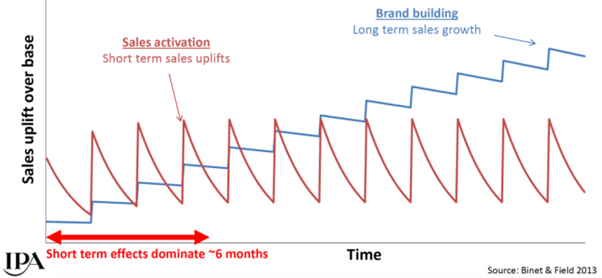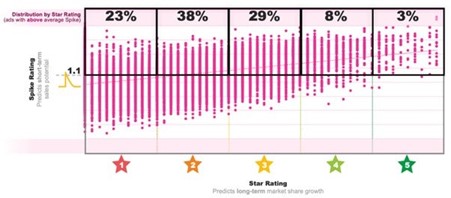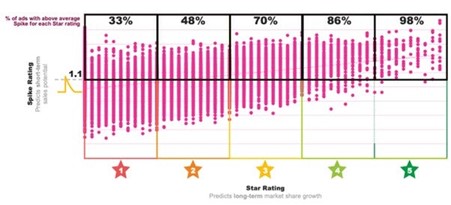
Cremarc is very much an advocate for brand building, and the importance of investing in brand over sales activation campaigns. Everyone at Cremarc is on the same page as Binet and Field’s The Long and The Short of It, putting brand building in the same camp as sales activation marketing. But new research suggests that they might not even be in the same camp anymore?
The short answer to the long-running debate
If you haven’t read Binet and Field’s The Long and The Short of It (TLATSOI), you’re missing out! It’s a fantastically insightful book on long-term growth marketing vs. performance marketing. In essence, is brand man Mark Ritson right, or is ‘the dark lord of penetration marketing’ Byron Sharp, correct? (Ritson’s words, not mine!)
The book features a graph that represents the improved performance of brand building campaigns exponentially over time, and the constant peaks and troughs of sales activation campaigns – thus, illustrating that brand building is better in the long-term. Additionally, the costly signalling of investing in your brand is stronger than a ‘quick sell’. For consumers, there’s more trust because of the perceived longevity of an organisation investing in their longer-term success.

Source: The Long and The Short of It – Les Binet & Peter Field
Essentially, this debate has been hard-fought out, but there was an answer that was generally accepted.
Brand building is more effective than sales activation over time. A 60:40 split prevails.
Interestingly, everyone focused on the time identifier in that statement to emphasise their point that brand building trumps sales activation. If businesses were prepared to invest in their future, they lived by this marketing ideology. However, many businesses continued to spend marketing budget on performance marketing staff and sales activation campaigns. They saw the short-term gains, and ignored the potential compounding success.
New research now suggests that these performance-investing businesses have not only been shooting themselves in the feet in the long-term, but also in the short.
The marketing truth has changed in 2024
10 years after TLATSOI was published, we’ve seen a massive pivot in the hero idea. TLATSOI was based on around 1000 marketing campaigns, extracted from various award nominations, at the time of the research. Many people have called out the wide-spread differentiation between a brand with award-nominated campaigns and the smaller organisations who could only dream of such. It’s true. The sample size probably wasn’t big enough, and even worse, totally unrepresentative of the full business world.
Furthermore, in the words of Mark Ritson:
“The idea of ‘the long and the short’ struck a chord with marketers because it emerged at a very particular moment in the history of the discipline. The emergence and growth of new digital media formats was revolutionising much of marketing thinking. But along with some genuine advances and improvements, this digital turn also favoured a focus on shorter, almost immediate timelines.”
So, with a substantial piece of research coming out at such a revolutionary time, did marketers get too excited too quickly?
The new research suggests that brand building trumps sales activation in the long-term, and even holds up in the short-term. So, how did we all get this so wrong, for so long?
Janet Hull, who wrote the foreword for TLATSOI, suggested that marketers were incorrectly focusing on the performance metrics which was subsequently decreasing brand profitability. The book definitely got this right. Marketers focus on driving a CTA on the initial touchpoint rather than 4 or 5 down the line. This was, always has been, and still is a big problem in marketing. The onus is both on marketers and businesses. Businesses shouldn’t push marketers for vanity metrics like followers and website traffic – they should ask for comments, shares, website session duration etc. Businesses should trust marketers to achieve what’s best for the brand. In turn, marketers can’t be lazy. They need to think about the long-term and deliver results month-on-month, with constant creative forecasting to predict what the next campaign could possibly achieve.
Until now, marketers have either listened to their C-suite’s requests and doomed themselves from Day 1, or they’ve challenged requests and been unable to achieve their own performance marketing goals.
Here’s some research that everyone in business should read – it explicitly states the importance of brand building.
The new marketing answer
Thanks to System1, ad trackers, and efficacy checkers, the new research gives us a better, truer framework to use. It’s not 60:40 anymore. It’s more like 75:25 in the favour of brand building.
Multiplying TLATSOI’s data set by twentyfold, they measured 18,000 adverts across a four-year span, and acquired some very interesting insights.
TLATSOI was read in a particular way by marketers – they saw it as brand building is more effective in the long-term because it has exponential compounding effects on advertising efficacy, while sales activation is more effective in the short-term as it provided a peak in sales and therefore an influx in short-term profitability.
System1 generates both a short-term ‘Spike Rating’ and a longer-term ‘Star Rating’ for each advert that they measure. If the above paragraph was accurate, each ad would either have a huge Star Rating and a small Spike Rating, or the opposite. Spoiler alert – they don’t.

Source: System1, 2023
This diagram shows that average Spike Rating ads are 23% more likely to be Level 1 Star Rating ads – Level 1 being the lowest tier prediction of long-term market share growth.

Source: System1, 2023
This is the fascinating part. On the flipside, an advert with an average Star Rating of 5 is also above average for its short-term Spike Rating 98% of the time.
Conclusively, the short is not effective in the long, but the long is effective in both the long and the short.
With this new research, marketers should shift their advertising and communications budget across to brand building campaigns because they are more effective in the long-term, driving brand profitability, and also almost as effective in the short-term – driving a clearer and more measurable ROI.
75:25 is the new split, maybe even 80:20. But from now on, marketers would be remiss to continue investing in sales activation. Think brand.